The organic light-emit TIng diode (OLED) is a patented display technology developed by Kodak that uses organic polymeric materials as a semiconductor material in light-emitting diodes. The polymeric material may be natural or synthetic, and may be very large in size or small in size. Proteins and DNA are examples of organic polymers.
OLED display technology is widely used in mobile phones, digital video cameras, DVD players, personal digital assistants (PDAs), notebook computers, car stereos and televisions. OLED displays are thin and light because they don't use backlights. The OLED display also has a wide viewing angle of up to 160 degrees, and its operating voltage is two to ten volts (volt, expressed in V). A new OLED-based technology is Soft Organic Luminescence Display (FOLED), which has the potential to enable highly portable, folded display technologies in the future.
Oled manufacturingThe most important part of the OLED production process is the application of an organic layer to the substrate. There are three ways to do this:
1. Vacuum deposition or vacuum thermal evaporation (VTE)
The organic molecules located in the vacuum chamber are slightly heated (evaporated) and then the molecules are condensed in the form of a film on the lower temperature substrate. This method is costly but less efficient.
2. Organic vapor deposition (OVPD)
In a low-pressure hot-wall reaction chamber, the carrier gas transports the evaporated organic molecules to the low-temperature substrate, and then the organic molecules condense into a film. The use of carrier gas can increase efficiency and reduce the cost of OLEDs.
3, inkjet printing
The inkjet technology is used to spray the OLED onto the substrate as if the ink was sprayed onto the paper during printing. Inkjet technology greatly reduces the cost of OLED production, and can print OLEDs onto very large surface areas for large displays such as 80-inch large-screen TVs or electronic signage.
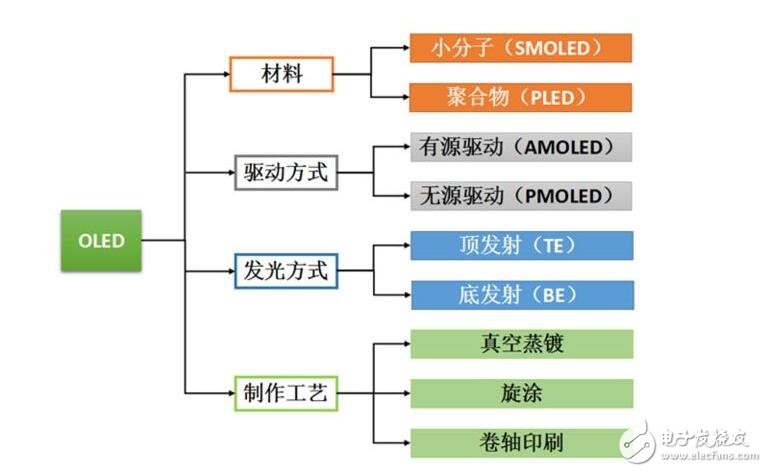
Depending on the use of organic functional materials, OLED devices can be divided into two broad categories: small molecule devices and polymer devices. Small molecule OLED technology developed earlier (1987), and the technology has reached commercial production levels. Polymer OLED, also known as PLED (PolymerLED), was developed in 1990. Since the polymer can be prepared by spin coating, inkjet printing, etc., it is possible to greatly reduce the production cost of the device, but the technology is far from mature.
Depending on the driving method, OLED devices can also be classified into passive drive type (Passive Matrix, PM, also known as passive drive) and active drive type (AcTIve Matrix, AM, also known as active drive). The passive drive type does not use a thin film transistor (TFT) substrate, which is generally suitable for small and medium size display; the active drive type uses a TFT substrate, which is suitable for medium and large size display, especially large size full color dynamic image display. At present, passive-driven OLED technology is relatively mature, and most of the commercialized products are passive-driven; active-driven OLED technology is developing rapidly, but it takes a certain time to launch commercial products in large quantities.
The following are several types of OLEDs: passive matrix OLED, active matrix OLED, transparent OLED, top emitting OLED, foldable OLED, white OLED, and the like.
Each OLED has its own unique use. Next, we will discuss these OLEDs one by one. The first is passive matrix and active matrix OLED.
Passive Matrix OLED (PMOLED)
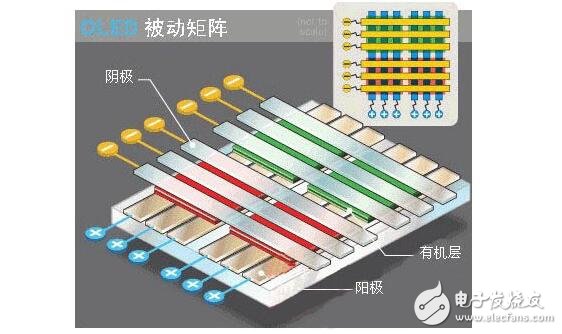
Passive matrix OLED structure
The PMOLED has a cathode strip, an organic layer, and an anode strip. The anode strip and the cathode strip are perpendicular to each other. The intersection of the cathode and the anode forms a pixel, that is, a portion where light is emitted. The external circuit applies a current to the selected cathode strip and anode strip to determine which pixels are illuminated and which are not. In addition, the brightness of each pixel is proportional to the magnitude of the applied current.
PMOLEDs are easy to manufacture, but they consume more power than other types of OLEDs, mainly because they require external circuitry.
PMOLED is the most efficient for displaying text and icons, suitable for making small screens (2-3 inches diagonally), such as people on mobile phones, palmtops
And the kind that is often seen on MP3 players. Even with an external circuit, the passive matrix OLED consumes less power than the LCDs currently used in these devices.
Active Matrix OLED (AMOLED)
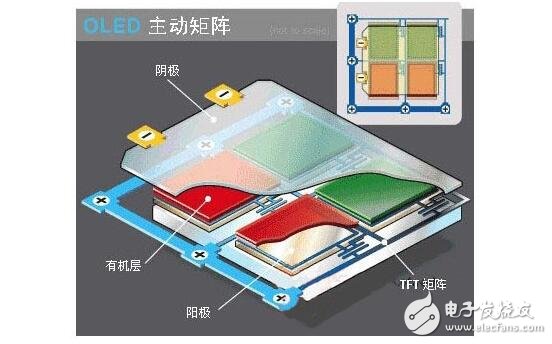
Active matrix OLED structure
The AMOLED has a complete cathode layer, an organic molecular layer, and an anode layer, but the anode layer is covered with a thin film transistor (TFT) array to form a matrix. The TFT array itself is a circuit that determines which pixels emit light and determines the composition of the image.
AMOLEDs consume less power than PMOLEDs because TFT arrays require less power than external circuits, making AMOLEDs suitable for large displays. AMOLED also has a higher refresh rate and is suitable for displaying video. The best use of AMOLEDs is in computer displays, large screen TVs, and electronic signage or billboards.
Transparent OLED
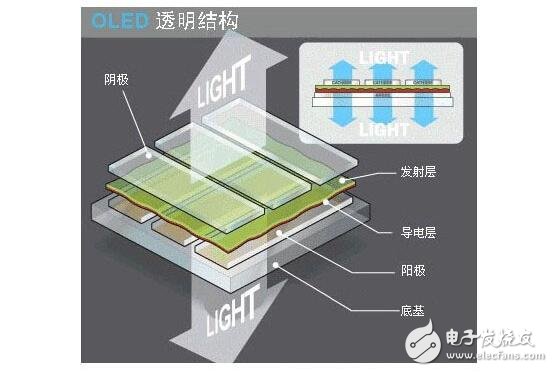
Transparent OLED structure
Transparent OLEDs only have transparent components (base layer, anode, cathode) and have a transparency of up to 85% of the transparency of the substrate when not emitting light. When the transparent OLED display is powered, the light can pass in both directions. Transparent OLED displays can be either passive or active. This technology can be used to make head-up displays that are used on airplanes.
Top emitting OLED
The top emitting OLED has an opaque or reflective base layer. They are best suited for active matrix design. Manufacturers can make smart cards with top-emitting OLED displays.
Top emitting OLED structure
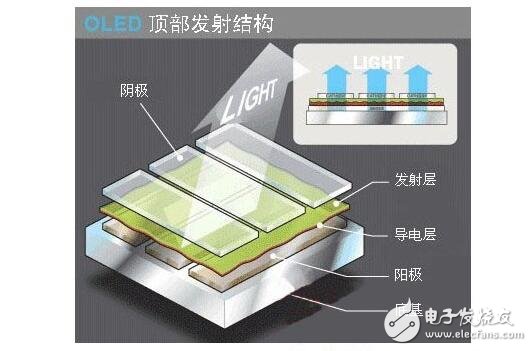
Foldable OLED
The base layer of the foldable OLED is made of a flexible metal foil or plastic. The foldable OLED is lightweight and extremely durable. They can be used in devices such as mobile phones and palmtops to reduce equipment breakage, which is a major cause of returns and repairs. In the future, collapsible OLEDs may be stitched into fibers to make a very "smart" garment. For example, future fieldwear can integrate computer chips, mobile phones, GPS receivers and OLED displays. Get up and stitch it inside the clothes.
White OLED
The brightness, balance and energy efficiency of white light emitted by white OLEDs are higher than those of white light. White OLEDs also have the true color characteristics of incandescent lighting. We can make OLEDs into large-area lamellas, so OLEDs can replace the fluorescent lamps currently used in homes and buildings. In the future, the use of OLEDs is expected to reduce the energy consumption required for lighting.
Classification of macromolecules and small molecules of OLED display technology
At present, there are two different processes for the practical manufacturing technology of OLED devices: one is to use a polymer organic polymer, and the other is to use a low molecular organic polymer.
Polymers, also known as polymer light-emitting diodes (PLEDs), were first discovered by Jeremy Burrard of the University of Cambridge and colleagues. PLED is an abbreviation for polymer light-emitTIng diode, that is, the second organic light-emitting material is a high molecular polymer. Most of the polymers are bonded together in a chain manner by small organic molecules, and a polymer organic light emitting diode is formed by spin coating.
In 1990, the Friend research team at the University of Cambridge in the United Kingdom first used P-phenylene acetylene (PPV) to make PLED devices, which produced yellow-green light at 14 V, creating a new era of research on polymer electroluminescent materials. PPV-based polymers were first proposed as electroluminescent materials, and the modified and modified PPV derivatives are also the most studied type of conductive polymer luminescent materials because of their excellent comprehensive properties.
Small molecule OLED (OLED) macro OLED (PLED)
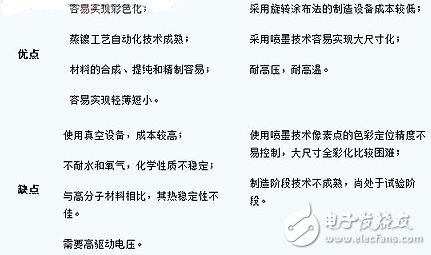
The preparation of high quality polymer films is the key to the fabrication of PLED devices. Compared with small molecular materials, polymers can be made into soluble materials through structural adjustment. There are many ways to form films, such as spin coating, printing, printing, etc., and printing equipment with lower cost can be used, so it is relatively small. Molecular LEDs, PLEDs have the advantage of low cost. It is conceivable that with the continuous development of high-performance polymer materials and the further improvement of thin film preparation technology, the industrialization of PLED will accelerate development and present a comparative advantage.
Scientists at the University of Cambridge first discovered that the conductive polymer material PPV has good electroluminescence properties and made PLED devices, which deeply recognized the development potential of PLED. In 1992, CDT (Cambridge Display Technology) was established. Professor Heeger (winner of the 2000 Nobel Prize in Chemistry), one of the founders of conductive polymers, founded Uniax in 1990. In 1992, the company's Cao Yu et al. used polyethylene terephthalate (PET) as a flexible transparent substrate material, and a conductive material of a mixture of polyaniline (PANI) or polyaniline was formed by solution spin coating. The conductive film produces a flexible PLED that presents the most fascinating side of the organic electroluminescent display to the world. The two companies are the patent holders of the most important OLED polymer technologies.
Low molecular polymer OLED (or SMOLED) is a small molecule OLED technology. The main components can be fabricated using vacuum evaporation techniques. Small organic molecules are packed in several layers on the ITO glass substrate. Compared to PLED-based devices, SMOLEDs offer a lower manufacturing process cost, provide display capability for all 262,000 colors, and have a long operating life.
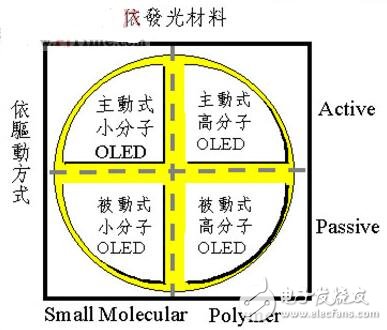
Organic small molecular materials are represented by metal chelates and rare earth complexes. In 1987, Tang CW first used this compound Alq3 to achieve a higher efficiency organic electroluminescent device. Common such substances are: Alq3, Al mqs, Zn( 5 Fa) 2, Be Bq2 and the like. A disadvantage of such luminescent materials is that they are difficult to separate during the manufacturing process. Other luminescent film materials with superior properties include Perylene, AromaTIcdiamine, TAD, TAP, T AZ, TPA, TPB, TPD, TPP and the like.
At present, the core patent of small molecule technology is mastered by its main discoverer, Kodak. Eastman Kodak’s patent licenses began to be dominated by Japanese manufacturers, and then Eastman Kodak Company gradually shifted its license to Taiwanese and Hong Kong manufacturers, including Taiwan’s Sic Bo, TECO Laser, Guanglei, and Union. Zong Optoelectronics and Truly International and Jingdian International in Hong Kong. Most of these Asian manufacturers that have obtained the OLED patent license from Eastern Kodak have LCD industry backgrounds, such as Sanyo and Samsung, which have considerable advantages in product development and market channels. Eastern Kodak chose these vendors as patent licenses to promote the commercialization of small molecule OLED technology.
At present, the technology and process of small molecule OLEDs are more mature than those of polymer OLEDs, and have entered the stage of marketization. Therefore, most of the OLEDs on the market are small molecules, small and medium size products, mainly used in MP3, mobile phones, vehicle equipment, instruments and meters.
OLED characteristicsOLED display technology has self-illuminating properties, using a very thin coating of organic materials and a glass substrate. When there is current, these organic materials will emit light, and the OLED display screen has a large viewing angle and can save power. This display device was introduced on the MP3 player in the beginning of the year.
In view of the organic luminescent materials used in OLEDs, one is a small molecular device system using dyes and pigments, and the other is a polymer device system using conjugated polymers as materials. At the same time, since the organic electroluminescent device has the characteristics of rectifying and emitting light of the light emitting diode, the small molecule organic electroluminescent device is also called OLED (Organic Light Emitting Diode), and the polymer organic electroluminescent device is called PLED (Polymer). Light-emitting Diode).
Small molecule and polymer OLEDs can be said to have different materials in terms of material properties. However, in terms of the development of existing technologies, such as the reliability of monitors, electrical characteristics, and production stability, small molecule OLEDs are in a leading position. The OLED components currently in mass production are all using small molecule organic luminescent materials.
Organic light-emitting display devices are favored because they have outstanding technical advantages compared to second-generation displays represented by LCDs:
â—It has low cost characteristics, simple process and less raw materials used;
â— With self-illuminating characteristics, no backlight is required;
â— With low voltage drive and low power consumption, DC drive voltage is below 10 volts, easy to use on portable mobile display terminals;
â—It has all solid-state characteristics, no vacuum chamber, no liquid component, good mechanical performance, strong anti-vibration, and can realize soft screen display;
â— With fast response characteristics, the response time is microsecond, which is 1000 times faster than the response time of ordinary LCD monitors. It is suitable for playing dynamic images. It has wide viewing angle characteristics, and the viewing angles of up and down and left and right are close to 180 degrees.
â— With high-efficiency illuminating characteristics, it can be used as a new environmental protection light source
â—With a wide temperature range, it can work normally from minus 40 degrees Celsius to above 85 degrees Celsius;
â— With high brightness characteristics, the display effect is bright and delicate.
Rechargeable Battery,Solar Battery System,Solar System Battery,Portable Battery Bank
Sichuan Liwang New Energy Technology Co. , https://www.myliwang.com